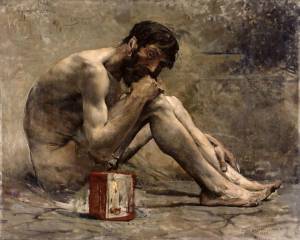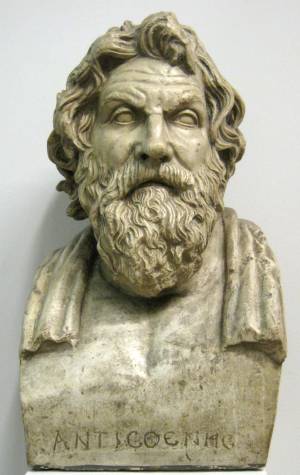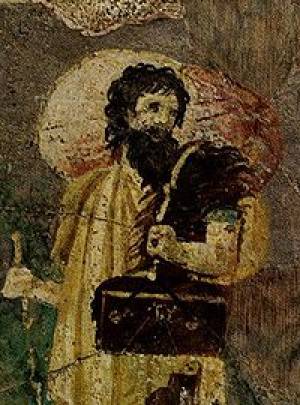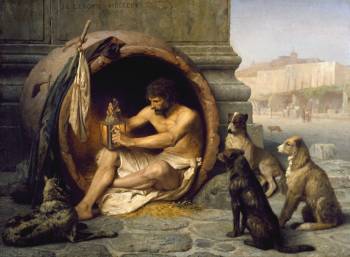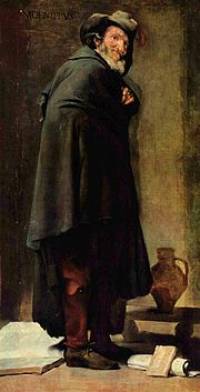Table of Contents
<html>
<a href=“http://lucianofsamosata.info/wiki/doku.php?id=submission_page”><img src=“http://lucianofsamosata.info/images/contact.png” /></a>
</html>
Lives & Writings on the Cynics
Source1)
<html><p><font color=“DarkRed”>Scroll DOWN page to view all Cynics</font></p></html>
† = No available online resources
“The nude Cynic fears no fire for his tub; if broken, he will make himself a new house to-morrow, or keep it repaired with clamps of lead.”
Juvenal, Satires (XIV.308ff)
Mythical Figures
- Heracles : Model figure for the Cynics; Heracles' life and trials were upheld by the Cynics to be an example of good behavior by living with the best principles.
- Typhon (Typhoeus) : Considered to be the most dangerous creature in mythology, the Cynics used Typhon as an archetype for what is perverse in the order of things. Just as Zeus struck-down Typhon in mythology, the imaginary Typhon needs to be vanquished in order for people to achieve freedom. Typhon is also related to the word “typhos” which translates as “smoke”. The Cynics believed that this smoke was representative of the chaos and illusion found in everyday living and beliefs.
Cynic Precursors
- Anacharsis : Scythian philosopher who travelled from his homeland on the northern shores of the Black Sea to Athens in the early 6th century BC and made a great impression as a forthright, outspoken “barbarian”, a forerunner of the Cynics, though none of his works have survived.4)
- Heraclitus : Pre-Socratic Greek philosopher, a native of the Greek city Ephesus, Ionia, on the coast of Asia Minor. He was of distinguished parentage. Little is known about his early life and education, but he regarded himself as self-taught and a pioneer of wisdom. From the lonely life he led, and still more from the riddling nature of his philosophy and his contempt for humankind in general, he was called “The Obscure” and the “Weeping Philosopher”.5)
- Hesiod : Hesiod's Works and Days work lays out the five Ages of Man, as well as containing advice and wisdom, prescribing a life of honest labour and attacking idleness and unjust judges (like those who decided in favour of Perses) as well as the practice of usury. It describes immortals who roam the earth watching over justice and injustice. The poem regards labor as the source of all good, in that both gods and men hate the idle, who resemble drones in a hive.6)
- Xenophanes : Poetry criticized and satirized a wide range of ideas, including Homer and Hesiod, the belief in the pantheon of anthropomorphic gods and the Greeks' veneration of athleticism. He is the earliest Greek poet who claims explicitly to be writing for future generations, creating “fame that will reach all of Greece, and never die while the Greek kind of songs survives.”8)
Historically Authenticated Cynics
Agathobulus of Alexandria - Antiochus of Cilicia
- Agathobulus of Alexandria 2nd Century AD : There is evidence that Agathobulus was an important person in his own time (see evidence of Plutarch); Agathobulus placed particular emphasis on some of the ascetic aspects of Cynicism: shamelessness and endurance of pain.
- Anaximenes of Lampsacus 4th Century BC : Anaximenes was a pupil of Zoilus and, like his teacher, wrote a work on Homer. As a rhetorician, he was a determined opponent of Isocrates and his school. He is generally regarded as the author of the Rhetoric to Alexander, an Art of Rhetoric included in the traditional corpus of Aristotle's works.9) Anaximenes is considered to be the first to speak extemporaenously.
- Androsthenes of Aegina 4th Century BC
- Antiochus of Cilicia 2nd and 3rd Century AD
Antisthenes of Athens
- Antisthenes of Athens Ca. 445 - 336 BC : Originally a subject of Gorgias the rhetorician, Antisthenes became disciple of Socrates. Antisthenes adopted the teachings of Socrates with an emphasis on Socratic ethics. He stressed living an ascetic life in accordance with Nature and Virtue. Many later writers considered Antisthenes to be the founder of Cynic philosophy.10)
Asclepiades - Cleomenes of Constantinople
- Asclepiades 2nd half of 4th Century AD : Cynic philosopher. He is mentioned by the emperor Julian whom Asclepiades visited at Antioch in 362. Ammianus Marcellinus describes how Asclepiades accidentally destroyed the temple of Apollo at Daphne in Antioch, when some candles he lit set light to the woodwork, burning down the temple.11)
- Avidienus 1st Century BC
- Besas 4th Century AD †
- Betion 3rd Century BC
- Bion of Borysthenes Ca. 335 - 245 BC : Influential in his time, Bion of Borysthenes was an ecletic figure in the 3rd Century BC. Bion's life and writings have the spirit of Cynicism and it is presumed that he contributed to the development of the diatribe.
- Cantharus 2nd Century AD
- Carneades 1st Century AD
- Cercidas of Megalopolis Ca. 290 - 220 BC : Poet, Cynic philosopher, and legislator for his native city Megalopolis. A papyrus roll containing fragments from seven of his Cynic poems was discovered at Oxyrhynchus in 1906.12)
- Chytron Fourth Century AD
- Cleanthes of Assos Ca. 331 - 231 BC
- Cleomenes of Constantinople 4th Century AD †
Crates of Thebes
- Crates of Thebes Ca. 360 - 280 BC : Crates gave away his money to live a life of poverty on the streets of Athens. He married Hipparchia of Maroneia who lived in the same manner that he did. Respected by the people of Athens, he is remembered for being the teacher of Zeno of Citium, the founder of Stoicism. Various fragments of Crates' teachings survive, including his description of the ideal Cynic state.14)
Crescens - Diocles
- Demetrius ? †
- Demetrius of Alexandria Ca. 300 BC
- Demetrius of Corinth 1st Century AD : Cynic philosopher from Corinth, who lived in Rome during the reigns of Caligula, Nero and Vespasian (37-71 AD). He was the intimate friend of Seneca, who wrote about him often, and who describes him as the perfect man.16)
- Demetrius of Sunium 2nd Century AD
- Demonax of Cyprus Ca. 70 - 170 AD : Greek Cynic philosopher. Born in Cyprus, he moved to Athens, where his wisdom, and his skill in solving disputes, earned him the admiration of the citizens. He taught Lucian, who wrote a Life of Demonax in praise of his teacher. When he died he received a magnificent public funeral.17)
- Didymus, nicknamed Planetiades 1st Century AD
- Diitrepes ?
- Dio Chrysostom Ca. 40 - after 112 AD
- Diocles ? †
Diogenes of Sinope
- Diogenes of Sinope 4th Century BC : Along with Antisthenes and Crates of Thebes, Diogenes is considered one of the founders of Cynicism. The ideas of Diogenes, like those of most other Cynics, must be arrived at indirectly. No writings of Diogenes survived even though he is reported to have authored over ten books, a volume of letters and seven tragedies. Cynic ideas are inseparable from Cynic practice; therefore what we know about Diogenes is contained in anecdotes concerning his life and sayings attributed to him in a number of scattered classical sources. Diogenes maintained that all the artificial growths of society were incompatible with happiness and that morality implies a return to the simplicity of nature. So great was his austerity and simplicity that the Stoics would later claim him to be a wise man or “sophos”. Diogenes had nothing but disdain for Plato and his abstract philosophy. Diogenes viewed Antisthenes as the true heir to Socrates, and shared his love of virtue and indifference to wealth, together with a disdain for general opinion. Diogenes shared Socrates' belief that he could function as doctor to men's souls and improve them morally, while at the same time holding contempt for their obtuseness. Plato once described Diogenes as “a Socrates gone mad.” Many anecdotes of Diogenes refer to his dog-like behavior, and his praise of a dog's virtues.18)
Diogenes the Sophist - Menestratus
- Diogenes the Sophist 1st Century AD
- Domitius ? †
- Echecles of Ephesus 4th and 3rd Centuries BC
- Favonius 1st Century AD
- Gorgias ? †
- Hegesias of Sinope 4th Century BC
- Heras Ca. 75 AD
- Hermodotus 1st Century AD †
- Hipparchia of Maronea 4th and 3rd Centuries BC : Cynic philosopher, and wife of Crates of Thebes. She was born in Maroneia, but her family moved to Athens, where Hipparchia came into contact with Crates, the most famous Cynic philosopher in Greece at that time. She fell in love with him, and, despite the disapproval of her parents, she married him. She went on to live a life of Cynic poverty on the streets of Athens with her husband.20)
- Honoratus 2nd Century AD
- Horus 4th Century AD † : Cynic philosopher and Olympic boxer who was victorious at the Olympic games in Antioch in 364.21)
- Iphicles 4th Century AD
- Isidorus 1st Century BC
- Maximus Hero of Alexandria 4th Century AD †
- Meleager of Gadara Ca. 135 - 50 BC : Poet and collector of epigrams. He wrote some satirical prose, now lost, and he wrote some sensual poetry, of which 134 epigrams survive. He also compiled numerous epigrams from diverse poets in an anthology known as the Garland, and although this does not survive, it is the original basis for the Greek Anthology.22)
- Menander, nicknamed Drumos 4th Century BC
- Menedemus of Lampsacus 3rd Century BC : Cynic philosopher, and a pupil of the Epicurean Colotes of Lampsacus.23)
- Menestratus 1st Century AD †
Menippus of Gadara
- Menippus of Gadara 1st Half of the 3rd Century BC : Cynic and satirist. His works, which are all lost, were an important influence on Varro and Lucian. The Menippean satire genre is named after him. Considered with Antisthenes, Crates, and Diogenes to one of the most important Cynics due to his influence on the satirical genre.24)
Menippus of Lycia - Zeno of Citium
- Menippus of Lycia 1st Century AD
- Metrocles of Maronea 3rd Century BC : Cynic philosopher from Maroneia. He studied in Aristotle’s Lyceum under Theophrastus, and eventually became a follower of Crates of Thebes who married Metrocles’ sister Hipparchia. Very little survives of his writings, but he is important as one of the first Cynics to adopt the practice of writing moral anecdotes (chreiai) about Diogenes and other Cynics.25)
- Monimus of Syracuse 4th Century BC : According to Diogenes Laërtius, Monimus was the slave of a Corinthian money-changer who heard tales about Diogenes of Sinope from Xeniades, Diogenes' master. In order that he might become the pupil of Diogenes, Monimus feigned madness by throwing money around until his master discarded him. Monimus also became acquainted with Crates of Thebes.26)
- Musonius Rufus 1st Century AD
- Oenomaus of Gadara 2nd Century AD : Pagan Cynic philosopher. He is known principally for the long extracts of a work attacking oracles, which have been preserved among the writings of Eusebius of Caesarea.27)
- Onesicritus of Astyalaea 380/375 - 305/300 BC : Greek historical writer, who accompanied Alexander on his campaigns in Asia. He claimed to have been the commander of Alexander's fleet but was actually only a helmsman; Arrian and Nearchus often criticize him for this. When he returned home, he wrote a history of Alexander's campaigns. He is frequently cited by later authors, who also criticize him for his inaccuracies.28)
- Onesicritus of Aegina 4th Century BC
- Ouranios Kunikos ? †
- Pancrates 2nd Century AD : Cynic philosopher. Philostratus relates, that when the celebrated sophist Lollianus was in danger of being stoned by the Athenians in a tumult about bread, Pancrates quieted the mob by exclaiming that Lollianus was not a bread-dealer (Greek: ἀρτοπώλης) but a word-dealer (Greek: λογοπώλης). Alciphron also mentions a Cynic philosopher of this name in his fictitious letters.29)
- Paniscus ? †
- Pasicles of Thebes 4th Century BC
- Peregrinus Ca. 100 - 165 AD : Cynic philosopher, from Parium in Mysia. Leaving home at a young age, he first lived with the Christians in Palestine, before eventually being expelled from that community and adopting the life of a Cynic philosopher and eventually settling in Greece. He is most remembered for committing suicide by giving his own funeral oration and cremating himself on a funeral pyre at the Olympic Games in 165. By 180 CE, a statue of Peregrinus had been erected in his home city of Parium; it was reputed to have oracular powers.30)
- Philiscus of Aegina 4th Century BC : Cynic philosopher from Aegina who lived in the latter half of the 4th century BC. He was the son of Onesicritus who sent Philiscus and his younger brother, Androsthenes, to Athens where they were so charmed by the philosophy of Diogenes of Sinope that Onesicritus also came to Athens and became his disciple. According to Hermippus of Smyrna, Philiscus was the pupil of Stilpo. He is also described as an associate of Phocion. The Suda claims that he was a teacher of Alexander the Great, but no other ancient writer mentions this. Aelian, though, has preserved a short exhortation by Philiscus addressed to Alexander: Take care of your reputation; don't become a plague or a great disaster, bring peace and health. The Suda mentions that Philiscus wrote dialogues including one called Codrus. Satyrus claimed that the tragedies ascribed to Diogenes were, in fact, written by Philiscus. Among the dialogues ascribed to Diogenes by Sotion, one is entitled Philiscus.31)
- Phocion the Good 4th Century BC
- Saloustios 5th Century AD †
- Secundus the Silent Philosopher Beginning of the 2nd Century AD : Cynic or Neopythagorean philosopher who lived in Athens in the early 2nd century, who had taken a vow of silence. An anonymous text entitled Life of Secundus (Latin: Vita Secundi Philosophi) purports to give details of his life as well as answers to philosophical questions posed to him by the emperor Hadrian. The work enjoyed great popularity in the Middle Ages.32)
- Serenianus 4th Century AD
- Sochares ? †
- Sotades of Maronea 3rd Century BC : Sotades was born in Maroneia, either the one in Thrace, or in Crete. He was the chief representative of the writers of obscene and even pederastic satirical poems, called Kinaidoi, composed in the Ionic dialect and in the “sotadic” metre named after him. The sotadic metre or sotadic verse, which has been classified by ancient and modern scholars as a form of ionic metre, is one that reads backwards and forwards the same, as “llewd did I live, and evil I did dwell.” These verses have also been called palindromic.33)
- Stilpo of Megara Ca. 360 - 280
- Teles Middle of the 3rd Century BC : Seven extracts of the lectures of Teles, totalling about thirty pages, are preserved by Stobaeus, although Stobaeus' own selections come from an earlier epitome by an otherwise unknown Theodorus.Thus what survives is a series of extracts from extracts, and it is quite possible that in between Teles and Theodorus, or Theodorus and Stobaeus, the writings went through a further editing process. The seven extracts are: Περὶ τοῦ δοϰεῖν ϰαὶ τοῦ εἶναι - On Seeming and Being, Περὶ αὐταρκείας - On Self-Sufficiency, Περὶ φυγῆς - On Exile, Σύγκρασις πενίας καὶ πλούτου - A Comparison of Poverty and Wealth, Περὶ τοῦ μὴ εῖναι τέλος ἡδονὴν - On Pleasure not being the Goal of Life, Περὶ περιστάσεων - On Circumstances, Περὶ ἀπαθείας - On Freedom from Passion. As a writer Teles has been regarded as being deficient in both literary and logical virtues, but this may reflect the way in which his works have been edited and compressed by Theodorus, Stobaeus, and others. The value of his writings lies in the fact that they are the earliest Cynic discourses (diatribes) to survive, and they provide an insight into the Hellenistic world in which Teles lived. His works make frequent mention of Socrates and Diogenes, and he preserves important fragments from the works of Crates of Thebes, Metrocles, Stilpo and Bion of Borysthenes. Without him we would know little about the Cynic diatribe in the 3rd-century BC, and we would know much less about Bion.34)
- Theagenes of Patras 2nd Century AD : Cynic philosopher and close friend of Peregrinus Proteus. He is known principally as a character who appears in Lucian's The Death of Peregrinus (Latin: De Morte Peregrini), where he is introduced as praising Peregrinus' desire to kill himself by self-immolation.35)
- Theombrotus 4th and 3rd Centuries BC
- Thrasyllus 4th Century BC
- Timarchus of Alexandria 2nd Half of the 3rd Century BC
- Varro 116 - 27 BC
- Xeniades of Corinth 4th Century BC
- Zeno of Citium Ca. 335 - 263
Anonymous Cynics
- Unknown Cynic 1 4th Century BC
- Unknown Cynic 2 4th and 3rd Centuries BC †
- Unknown Cynic 3 4th and 3rd Centuries BC
- Unknown Cynic 4 1st Century BC and 1st Century AD †
- Unknown Cynic 5 1st Century AD
- Unknown Cynic 6 1st Century AD †
- Unknown Cynic 7 1st Century AD †
- Unknown Cynic 8 2nd Century AD
- Unknown Cynic 9 2nd Century AD
- Unknown Cynic 10 2nd Century AD †
- Unknown Cynic 11 2nd Century AD †
- Unknown Cynic 12 4th Century AD †
- Unknown Cynic 13 4th Century AD †
- Unknown Cynic 14 4th Century AD †
Uncertain Link to Cynicism
- Demetrius of Alexandria, or Cythras 4th Century AD
- Diodorus of Aspendus 4th Century BC
- Eubulus 3rd Century BC
- Eubulides 3rd Century BC
- Hermias of Curium ? †
- Hostilianus 1st Century AD
- Nilus 4th Century AD †
- Sostratus Heracles 2nd Century AD
- Theoxenus 4th Century BC?
- Zoilus of Amphipolis, nicknamed Homeromastix 4th Century BC
Cynics in Epistles
Recipients of the Cynic Epistles
DIOGENES EPISTLES
Agesilaus (22), Amynander (21), Anaxlaus (19), Anniceris (27), Antalcides (17), Apolexis (13|16|18), Aruecas (49), Charmidas (50), Epimenides (51), Eugnesius (8), Hippon (25), Lacydes (23|cf.37), Melesippe (42), Melesippus (20|41), Phaennylus (31), Phanomachus (33), Rhesus (48), Sopolis (35), Timomachus (36)
Recipients of the Cynic Epistles
CRATES EPISTLES
Aper (35), Dinomachus (36), Eumolpus (13), Ganymedes (23), Hermaiscus (4), Lysis (10), Mnaso (9), Orion (12), Patrocles (19)
- Phynichus of Larissa †
Fictitious Cynics
- Agathocles †
- Cynulcus †
- Myrtilus †
- Nicion, called Dog Fly †
- Theodorus †
